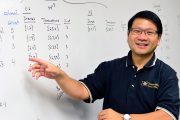Genetic targets for autism spectrum disorder identified by MU team
State-of-the-art computer techniques help narrow down genetic targets for diagnosis and treatment of autism
February 19th, 2018
COLUMBIA, Mo. – Autism is a spectrum of closely related symptoms involving behavioral, social and cognitive deficits. Early detection of autism in children is key to producing the best outcomes; however, searching for the genetic causes of autism is complicated by various symptoms found within the spectrum. Now, a multi-disciplinary team of researchers at the University of Missouri created a new computational method that has connected several target genes to autism. Recent discoveries could lead to screening tools for young children and could help doctors determine correct interventions when diagnosing autism.
Unlocking the genetic causes of autism requires data-intensive computations. In 2014, the National Science Foundation (NSF) awarded $1 million in two grants to MU to install a supercomputer enabling data-intensive research and education in the fields of bioinformatics and data-driven engineering applications.
“In this study we started with more than 2,591 families who had only one child with autism and neither the parents nor the siblings had been diagnosed with autism,” said Chi-Ren Shyu, director of the Informatics Institute and the Paul K. and Dianne Shumaker Endowed Professor in the Department of Electrical Engineering and Computer Science in the MU College of Engineering. “This created a genetically diverse group composed of an estimated 10 million genetic variants. We narrowed it down to the 30,000 most promising variants, then used preset algorithms and the big data capabilities of our high-performance computing equipment at MU to ‘mine’ those genetic variables.”
The genetic samples were obtained from the Simons Foundation Autism Research Initiative. Samples from children with diagnosed cases of autism, and their unaffected parents and siblings were collected leading to more than 11,500 individuals. Using advanced computational techniques, Shyu and his team were able to identify 286 genes that were then collected into 12 subgroups that exhibited commonly seen characteristics of children on the spectrum. Of these genes, 193 potentially new genes not found in previous autism studies were discovered.
“Autism is heterogeneous, meaning that the genetic causes are varied and complex,” said Judith Miles, professor emerita of child health-genetics in the MU Thompson Center for Autism and Neurodevelopmental Disorders. “This complexity makes it tough for geneticists to get at the root of what triggers the development of autism in more conventional ways. The methods developed by Dr. Shyu and the results our team identified are giving geneticists a wealth of targets we’d not considered before—by narrowing down the genetic markers, we may be able to develop clinical programs and methods that can help diagnose and treat the disease. These results are a quantum leap forward in the study of the genetic causes of autism.”
This informatics framework is ready for a much larger scale of autism research, such as genetic samples to be collected through the Simons Foundation Powering Autism Research for Knowledge (SPARK), the nation’s largest autism study. SPARK is partnering with scientists who hope to collect information and DNA for genetic analysis from 50,000 individuals with autism — and their families — to advance understanding of the causes of autism and hasten the discovery of supports and treatments. Anyone interested in learning more about SPARK or in participating in the study can visit: www.SPARKforAutism.org/MUTC, or contact Amanda Shocklee at (573) 884-6092 or shockleea@missouri.edu.
Matt Spencer, with the MU Informatics Institute; Nicole Takahashi, with the MU Thompson Center for Autism; and Sounak Chakraborty, with the MU Department of Statistics contributed to the research.
The study, “Heritable genotype contrast mining reveals novel gene associations specific to autism subgroups,” was published in the Journal of Biomedical Informatics. This work was supported by the National Institutes of Health (5T32GM008396, 5T32LM012410-02); the Shumaker Endowment for Biomedical Informatics; the National Science Foundation (CNS-1429294); and the Simons Foundation.
Editor’s Note: For more on the story, please see:
- MU researchers identify new genes for autism research
- University of Missouri Thompson Center recruiting children, adults with autism for landmark genetic study
- NSF grants boost big data capabilities at MU



 Photos (2):
Photos (2):